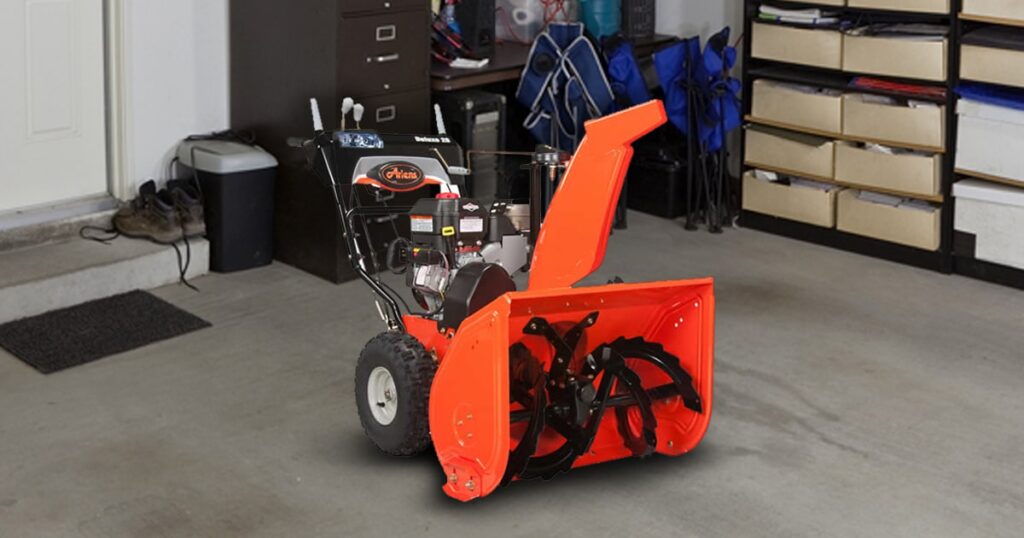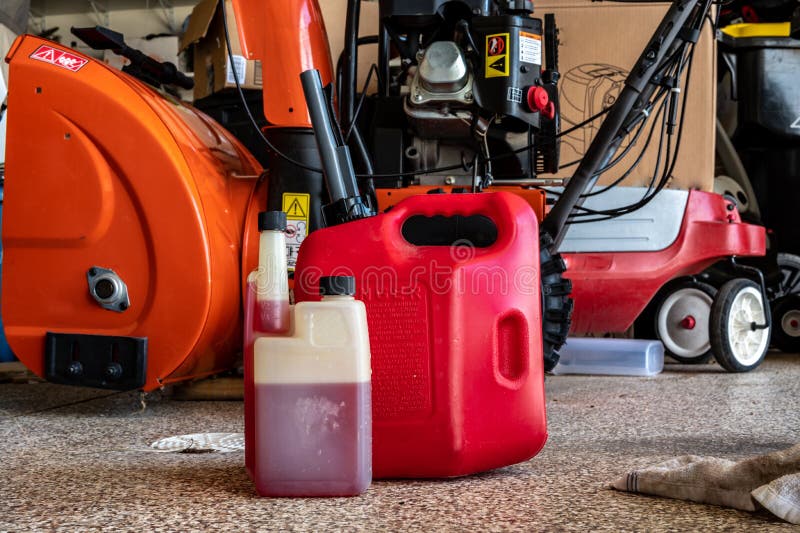So you finally dusted off your snowblower at the beginning of winter, ready to brave the icy streets and clear the snow-covered sidewalks. But now that the season is coming to an end, you’re left with the question of how to properly store your snowblower and its fuel until next year. After all, you don’t want to be surprised by a clogged carburetor or a sluggish performance when the snow starts falling again. In this article, we’ll explore some effective methods to stabilize the fuel for your snowblower’s long-term storage, ensuring that it’s ready to roar back to life when winter comes knocking.

This image is property of www.snowblowersdirect.com.
Why is fuel stabilization important for long-term storage?
Fuel stabilization is crucial for long-term storage of your snowblower because it helps prevent fuel degradation, avoiding engine damage, and maintaining optimal performance. When fuel is left untreated for an extended period, it can break down, resulting in the formation of gum and varnish. These deposits can clog the fuel system, including the carburetor, fuel lines, and injectors, leading to poor engine performance and potential damage.
Moreover, untreated fuel can deteriorate, resulting in the loss of its combustible properties. As a result, starting the snowblower after prolonged storage can become challenging, requiring extensive maintenance and repairs. By stabilizing the fuel, you can prevent these issues, ensuring that your snowblower remains in good condition and ready to use when the snow season arrives.
Choosing the right fuel stabilizer
To effectively stabilize the fuel for your snowblower’s long-term storage, it is essential to choose the right fuel stabilizer. There are different types of fuel stabilizers available on the market, and understanding their variations will assist you in making an informed decision.
Some stabilizers focus on preventing fuel degradation by inhibiting the formation of gum and varnish, while others also address issues like water accumulation and corrosion. Consider your snowblower’s specific needs and the storage conditions it will be subjected to when selecting a fuel stabilizer. For example, if you live in a humid climate, you may want to choose a stabilizer designed to combat moisture-related problems.
Reading product labels and reviews is also crucial in determining the quality and effectiveness of a fuel stabilizer. Look for products that have positive customer testimonials and clearly state their capabilities. Taking the time to research and select the right stabilizer will result in better outcomes for your snowblower’s long-term storage.

This image is property of thumbs.dreamstime.com.
Preparing the snowblower for storage
Before adding the fuel stabilizer, it is crucial to perform essential maintenance tasks on your snowblower. This ensures that the equipment is in good working condition and ready for storage.
Firstly, clean your snowblower thoroughly, removing any dirt, debris, or ice. Inspect all components, such as the spark plug, air filter, and belts, and replace any damaged or worn-out parts. Lubricate moving parts as necessary to prevent rust and corrosion during storage.
Next, drain excess fuel from the tank. Fuel left in the snowblower for an extended period can deteriorate, causing starting problems and damaging the engine. Consult your snowblower’s manual or manufacturer’s instructions to locate the fuel drain plug or valve. Place a fuel-safe container under the drain and open it to allow the fuel to drain completely.
To use up the remaining fuel in the snowblower, start the engine and let it run until it stalls and stops. This step is essential because even a small amount of untreated fuel left in the system can cause problems when starting the snowblower after storage.
Adding the fuel stabilizer
Once you have completed the necessary preparations, it’s time to add the fuel stabilizer to your snowblower. Determine the correct amount of stabilizer to use by referring to the product’s instructions or the recommended dosage provided by the manufacturer.
With a fresh container of fuel, mix the appropriate amount of stabilizer into the fuel. It is important to use fresh fuel because stale fuel can already contain contaminants that could affect the effectiveness of the stabilizer. Thoroughly mix the fuel and stabilizer to ensure even distribution of the stabilizing agents throughout the tank.

This image is property of www.guardianstorage.com.
Running the snowblower with the stabilized fuel
After adding the fuel stabilizer, let the snowblower’s engine run for a few minutes. This allows the treated fuel to circulate through the fuel system and reach all engine components, ensuring effective protection against degradation and corrosion during storage.
While the engine is running, pay close attention to any signs of engine trouble. Unusual noises, smoke, or erratic behavior may indicate a problem that should be addressed before storing the snowblower. If you notice any issues, consider consulting a professional for assistance or performing additional troubleshooting steps as appropriate.
Storing the snowblower properly
Choosing the right storage location for your snowblower is essential to maintain its longevity. Ideally, store your snowblower in a clean, dry, and well-ventilated area to prevent moisture buildup, which can contribute to rust and corrosion. If possible, keep the snowblower in a covered space, such as a garage or shed, to protect it from the elements.
While in storage, it is a good practice to cover the snowblower with a tarp or a specialized cover designed specifically for outdoor power equipment. This helps prevent dust, debris, and humidity from accumulating on the equipment, ensuring that it remains in optimal condition during the off-season.

This image is property of www.weingartz.com.
Regular maintenance during storage
Even in storage, it is important to periodically check on your snowblower to ensure it remains in good condition. At regular intervals, inspect the snowblower for any signs of damage, corrosion, or pests that may have found their way into the storage area. Topping off the fuel if necessary can also help maintain fuel quality.
Inspecting the fuel system, including the tank, fuel lines, and filter, can help identify any issues or possible leaks. It is also a good idea to start the snowblower periodically and let it run for a short time to prevent fuel from sitting stagnant in the system for too long.
Preparing the snowblower for use
Before you are ready to use your snowblower again, it is important to properly prepare it after storage. Start by draining the stabilized fuel from the tank. Make sure to follow the appropriate safety guidelines for disposing of the fuel, especially if it contains stabilizing agents.
After draining the fuel, clean the fuel system components such as the carburetor, fuel lines, and filter. Use a fuel system cleaner or follow the manufacturer’s recommendations to remove any residue or deposits that may have accumulated during storage.
Once the fuel system is clean, refill the tank with fresh fuel. Before adding the new fuel, ensure that any residual stabilizer from the previous season is completely removed. Mixing old and new fuel can affect the performance of the snowblower, so it is essential to start with a clean system.

This image is property of www.simplystoring.com.
Proper disposal of stabilized fuel
When disposing of the stabilized fuel, it is important to follow local regulations and guidelines to avoid any environmental harm. Stabilized fuel should never be poured down drains, into bodies of water, or directly onto the ground.
Consult with local waste management facilities or recycling centers to determine the appropriate method of disposal. They will provide guidance on how to safely dispose of stabilized fuel in accordance with local regulations.
Common troubleshooting tips
In the event of fuel-related issues with your snowblower, there are some troubleshooting steps you can take. If the snowblower is experiencing starting problems or running poorly, consider draining the fuel system completely and cleaning the components as previously mentioned.
If troubleshooting steps do not resolve the issue, it may be time to seek professional assistance. A certified technician will have the expertise and tools necessary to diagnose and repair any complex fuel stability problems or engine-related issues with your snowblower.
To prevent future fuel stability problems, always use a fuel stabilizer when storing your snowblower long-term. Following the steps outlined in this article will help ensure that your snowblower remains in good running condition and is ready for use when needed. Regular maintenance, proper storage, and attention to detail will prolong the life of your equipment and save you from unnecessary repairs down the line.
